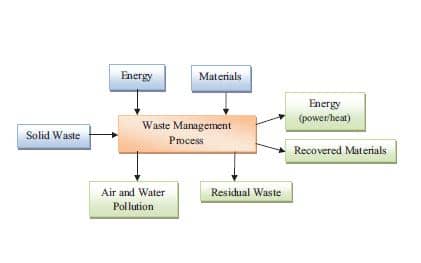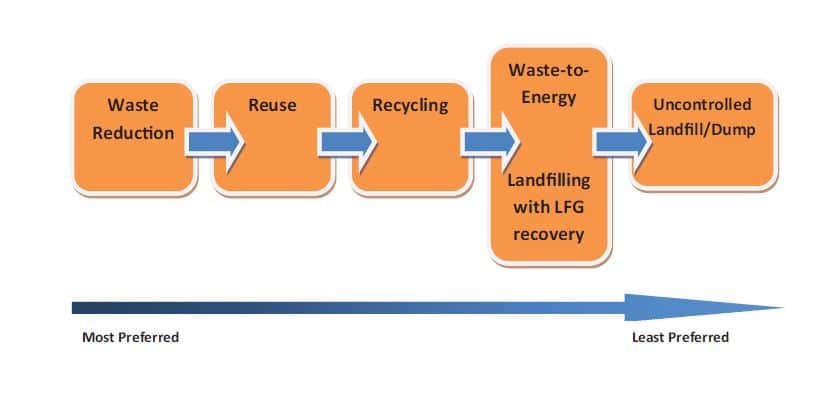Solid Waste Management
The Importance of Landfill Gas Energy in Integrated Municipal Solid Management in the Developing World
Incorporating integrated solid waste management and landfill gas energy best practices can go a long way to protecting human health and the environment from the dangers of improperly managed and disposed waste. Finding the proper mix of practices to meet a local community’s means and needs will help ensure a healthier population and environment.
Brian Guzzone and Amy Alexander
As the world’s population reached 7 billion in 2011, the demand for access to improved sanitation steadily increases as a result of a burgeoning middle class in the developing world. Further, by 2050, the world will include more than nine billion people.1 Each year the world’s population generates more than 2 billion tons of waste; if society continues to move toward the current waste generation patterns of the wealthiest cities in high-income countries today, then by 2025, we could be generating as much as 7 billion tons of waste each year.2 Rapid population growth coupled with increasing prosperity in developing countries requires a serious examination of the waste management process (Figure 1) and the role of integrated solid waste management (ISWM) to safeguard the environment against air and water pollution and residual waste, protect public health, and maximize the value-added elements (i.e., energy and recovered materials).
Waste Disposal
Currently, between 30 and 60 percent of solid waste from cities in developing countries remains uncollected and ends up on the street or disposed of through open burning.3 This is a major public health and environmental concern affecting rich and poor alike, and poses enormous problems for growing cities and towns. However, due to rapid increases in population and urbanization, an increasing number of developing countries are beginning to use some form of landfill (i.e., uncontrolled or controlled dump, sanitary landfill) to manage increasing waste generation rates. Worldwide, the majority of waste is disposed of in landfills which alleviate several public health concerns, but creates additional environmental considerations. Landfills provide an anaerobic environment for wastes to decay that causes the release of landfill gas (LFG), odors and a host of other potential air, water and soil pollutants. The methane produced by landfills is of environmental significance because methane is a potent greenhouse gas and its ability to trap heat in the atmosphere, called its “global warming potential,” is more than 20 times greater than that of carbon dioxide. Globally, landfills are the third largest anthropogenic source of methane, accounting for approximately 11 percent of estimated global methane emissions or nearly 799 million metric tons of carbon dioxide equivalent (MMTCO2E) emissions in 2010.4 As a constituent of natural gas, however, methane offers a unique opportunity to mitigate climate change and simultaneously increase available energy supply. Therefore, efforts to prevent or utilize methane emissions can provide significant energy, economic, and environmental benefits.
As developing countries transition to controlled or sanitary landfills, methane emissions will rise as more waste is managed in a proper manner which is conducive to LFG generation. Therefore, LFG collection and control measures are of increasing importance to offset these emissions. Moreover, the lowest-cost and often the most expedient solution is disposal of waste in uncontrolled landfills or dumpsites. Due to the relatively high cost of sanitary landfills, cities tend to make little progress toward landfill implementation unless the regulatory framework and environmental agencies apply enforcement pressure.5 Meanwhile, in many developed nations, the availability of landfill capacity has been flat or steadily decreasing due to regulatory, siting and environmental permitting constraints on new landfills and landfill expansions. As a result, new approaches to waste management are rapidly being written into public and institutional policies at local and national levels.
Solid waste management is usually one of the most labor and cost intensive services provided by local governments in developing countries and local government officials are frequently besieged by companies selling solid waste management technologies. Many of these technologies may not be appropriate and officials may have limited experience for assessing a company’s claims and technological viability that has resulted in many systems that have been built, only to close shortly after costly startup, operations and maintenance. Therefore, helping local governments choose appropriate solid waste management strategies and technologies is critically important.
Major Components of Integrated Solid Waste Management
To address global waste management challenges, countries have focused on developing and implementing a variety of ISWM strategies to tackle the long-term management of waste. For the purposes of this article, the six major components of ISWM (Figure 2) are categorized as:
Waste reduction;
Reuse;
Recycling (including composting and anaerobic digestion);
Waste-to-energy (i.e., waste combustion, gasification, pyrolysis);
Landfilling with LFG recovery (i.e., flaring and energy utilization); and
Landfilling in an uncontrolled dump site with little or no environmental controls.
Role of ISWM in Developing Sustainable Waste Management Practices
While a generally agreed upon ISWM hierarchy exists, the selection of methods of management should be based upon the needs and means of the local government as well as environmental regulations and national, regional and local policies. Each community must decide which waste management methods make sense for it based upon its unique environmental needs, economic situation and public policies. Additionally, no one process or technology can handle all of a community’s waste, therefore a number of integrated methods for proper waste management should be considered. Initiatives from one country cannot always be exported to another and be expected to work as the local volume and composition of waste, infrastructure, economic resources, climate and cultural traditions and norms can vary significantly. For example, constructing a waste-to-energy plant in a developing country with high levels of wet organic waste such as food waste may cause operational challenges and increase costs because many WTE technologies are designed to burn wastes that are lower in wet food wastes and higher in readily combustible materials such as paper and plastics. In addition, economic considerations must be evaluated to determine the most appropriate solutions. For example, constructing a plasma gasification project in a small rural community (e.g., 25,000 inhabitants) may prove uneconomical due to the higher capital costs associated with the technology. The key to effective ISWM is the design and development of waste management systems that are best fit to local needs and challenges. Developing countries are beginning to recognize the need for a comprehensive approach to undertake sustainable waste management practices. In Argentina, the federal government has embarked on a national ISWM strategy that includes closure of uncontrolled dump sites in favor of regional modern sanitary landfills to serve populations from local communities and businesses.
Role of Landfill Gas in ISWM
Recovery of LFG is a critical component of ISWM. LFG recovery for flaring or energy is an effective method to reduce uncontrolled air emissions and improve public health and safety and the environment. With multiple environmental, social, and economic benefits, LFG energy plays a critical role in municipal solid waste (MSW) management. LFG energy is a small but important component of an integrated approach to solid waste management given that the use of landfills continues to remain the predominant method of waste disposal in most countries. The U.S. Environmental Protection Agency waste hierarchy6 treats landfills and incineration equally, as environmentally acceptable disposal options for MSW. However, source reduction, recycling and composting are the more environmentally preferred waste management options. When these preferred methods of waste management are not employed and the use of landfills is the available option, energy recovery improves the greenhouse gas profile and makes use of the energy generated as the organic fraction of MSW decomposes. Where landfills exist, the use of methane generated by the decomposing waste already in place to produce energy is the best-case option to reduce greenhouse gas emissions and provide an alternative to fossil fuel-based power generation. Many landfills in developed countries already collect LFG and either use it to power engines for electricity generation, transmit it in a pipeline to a nearby end user to replace fossil fuel use (e.g., boiler, kiln, dryer), or flare it. Internationally, significant opportunities exist for expanding LFG energy (see LFG Energy Recovery Technologies sidebar). One such effective approach to reducing landfill methane emissions is the Global Methane Initiative (GMI), an international public–private partnership that brings together 40 governments and the private sector to develop projects that can reduce emissions from the agriculture, coal mine, landfill, oil and gas systems, and municipal wastewater sectors. Cumulative methane emission reductions achieved through GMI total more than 128 million metric tons of carbon dioxide equivalent (MMTCO2E). For more information, visit www.globalmethane.org.
Incorporating ISWM and LFG energy best practices can go a long way to protecting human health and the environment from the dangers of improperly managed and disposed waste. Finding the proper mix of practices to meet a local community’s means and needs will help ensure a healthier population and environment.
Brian Guzzone is a Senior Climate Analyst for ERG (Arlington, VA).He has 17 years of technical and outreach expertise in climate change, methane mitigation, and solid waste management. Brian worked in EPA’s Climate Change Division for nearly 10 years where he designed, developed and implemented greenhouse gas mitigation strategies for programs targeting methane and other non-CO2 gases. He was instrumental in the development of specific EPA methodologies for emissions and offsets of landfill methane. Brian currently manages ERG’s international outreach efforts including engineering, scientific and economic analysis support for major domestic and international climate programs such as EPA’s Landfill Methane Outreach Program and the Global Methane Initiative. He can be reached at [email protected].
Amy Alexander is a Senior Environmental Engineer for ERG (Morrisville, NC). She has 15 years of technical experience in air quality, including evaluating landfill and LFG technologies and emissions, constructing emission estimation methodologies and inventories, evaluating and costing greenhouse gas mitigation technologies, designing software models, and reviewing and preparing air permits. Amy has provided technical assistance and outreach support to EPA’s LMOP for more than seven years. She constructed and routinely enhanced LMOP’s LFGcost model for conducting economic assessments of LFG energy projects. She assisted EPA’s Office of Research & Development with the 2005 upgrade of the Landfill Gas Emissions Model (LandGEM) to make the tool more user-friendly and improve its LFG generation estimates. Amy can be reached at [email protected].
Notes
Population Reference Bureau. 2011. http://www.prb.org/
UN-HABITAT. 2010. “Solid Waste Management in the World’s Cities, Water and Sanitation in the World’s Cities 2010,” http://www.waste.nl/page/1757.
Ibid.
U.S. EPA. 2011. DRAFT: Global Anthropogenic Emissions of Non-CO2 Greenhouse Gases: 1990–2030 (EPA 430-D-11-003). http://www.epa.gov/climatechange/economics/international.html.
The World Bank. 2011. Analysis of Technology Choices. http://web.worldbank.org/WBSITE/EXTERNAL/TOPICS/EXTURBANDEVELOPMENT/EXTUSWM/0,,contentMDK:20239704~menuPK:497751~pagePK:148956~piPK:216618~theSitePK:463841,00.html
Frankiewicz, T.A., C.A. Leatherwood , and B.L. Dieleman. “Landfill Gas Energy: An Important Component of Integrated Solid Waste Management,” LMOP LFG 34 Paper, 2011. http://www.scsengineers.com/Papers/Leatherwood_Dieleman_(2011)_LFGE-Important_Component_of_Integrated_SWM.pdf
Figure 1
Lifecycle inputs and outputs of a waste management process.
Figure 2
Preferred components of integrated solid waste management.
Figures provided courtesy of EPA’s Landfill Methane Outreach Program (LMOP).
Sidebar
LFG Energy Recovery Technologies
Direct thermal
Boilers
Furnaces, dryers, kilns & process heaters
Infrared heaters
Leachate evaporation
Electricity generation
Internal combustion engines
Gas turbines
Microturbines
Combined heat & power
Conversion to high-Btu gas
Pipeline-quality gas
Compressed natural gas (CNG)
Liquefied natural gas (LNG)


